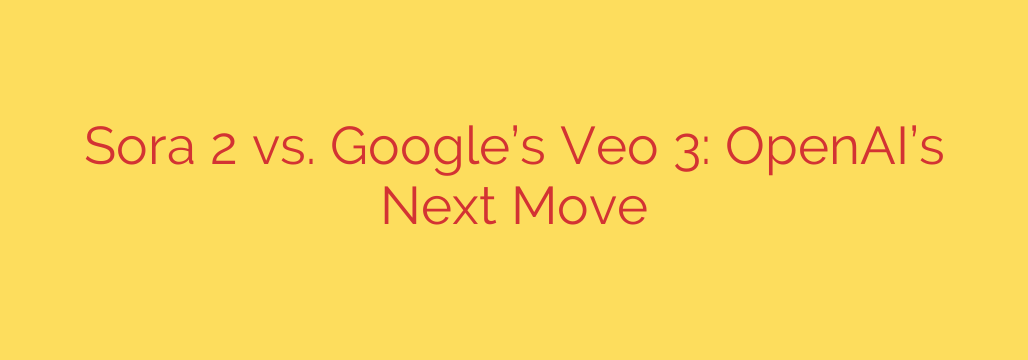
The AI Video Revolution: Sora vs. Veo and the Race for What’s Next
The world of artificial intelligence is moving at a breakneck pace, and nowhere is this more apparent than in the field of text-to-video generation. What was once science fiction is now a tangible reality, with two major players dominating the conversation: OpenAI’s Sora and Google’s Veo. This isn’t just a tech demo rivalry; it’s a battle to define the future of content creation, entertainment, and digital communication itself.
As these powerful models evolve, understanding their strengths, weaknesses, and the direction they are headed is crucial for creators, marketers, and anyone interested in the future of technology.
OpenAI’s Sora: The Cinematic Pioneer
When OpenAI first unveiled Sora, it sent shockwaves through the creative and tech communities. The sample videos showcased an unprecedented level of realism and a deep, almost intuitive understanding of how the physical world works. Sora demonstrated it could not only generate video from a text prompt but also interpret the nuances of motion, light, and texture.
Key strengths that set Sora apart include:
- Photorealistic Detail: Sora can generate scenes with stunning clarity and detail, often making it difficult to distinguish its output from actual camera footage.
- Complex Scene and Camera Dynamics: The model understands prompts that call for specific camera movements, like tracking shots or crane movements, adding a layer of cinematic quality that was previously unattainable.
- Coherent World Simulation: Unlike earlier models, Sora maintains a high degree of consistency within a scene. Objects and characters persist and interact logically, suggesting the AI is simulating a small, virtual world rather than just “painting” frames.
However, Sora is not yet available to the public and its current demonstrations are limited to one minute in length. While groundbreaking, it represents the opening move in a much larger game.
Google’s Veo: The Challenger with a Cinematic Vision
Not to be outdone, Google has thrown its hat into the ring with its own formidable model, Veo. Built upon years of Google’s extensive research in generative models, particularly its powerful Gemini AI, Veo is positioned as a direct and capable competitor to Sora.
Google has highlighted several key features that make Veo a powerful contender:
- High-Definition, Long-Form Content: Veo is designed to generate high-quality 1080p videos that can extend beyond the one-minute mark. This longer duration is a significant advantage for storytelling and more practical applications.
- Nuanced Cinematic Understanding: Google emphasizes Veo’s ability to interpret specific cinematic language. Prompts including terms like “timelapse,” “aerial shot,” or “long exposure” are understood and executed with impressive accuracy.
- Consistent and Realistic Outputs: Like Sora, Veo focuses heavily on maintaining character and visual consistency throughout a shot, ensuring that people, animals, and objects behave believably from one moment to the next.
Veo is also being integrated into platforms like YouTube Shorts, signaling Google’s intent to put these tools directly into the hands of its massive creator ecosystem.
Head-to-Head: Where Do They Stand?
While a true “winner” is impossible to declare since neither model is fully public, a comparison of their demonstrated capabilities reveals a tight race.
- Image Quality: Both models produce breathtakingly realistic visuals. Sora has often been praised for its slightly more artistic or “dreamlike” quality, while Veo’s output is noted for its clean, high-definition clarity.
- Prompt Interpretation: Sora excels at generating complex, dynamic scenes with a deep understanding of physics. Veo appears to have a slight edge in understanding specific, technical filmmaking terminology.
- The Next Frontier: The competition is now shifting toward the next generation of these models. Speculation around a “Sora 2” or an enhanced Veo centers on several key improvements: longer video generation (5+ minutes), integrated audio generation, greater user control over specific elements in the scene, and even more flawless physics.
Security and the Ethical Imperative
The rise of hyper-realistic AI video generators brings with it significant ethical and security concerns. The potential for creating convincing deepfakes for misinformation or malicious purposes cannot be ignored. Both OpenAI and Google have stated they are taking this threat seriously.
A key strategy being developed is digital watermarking. This involves embedding an invisible, permanent signature into the generated content, making it possible to identify it as AI-created.
As a user, it’s more important than ever to practice digital literacy. Here is some actionable advice:
- Always question the source of a video, especially if it depicts shocking or unbelievable events.
- Look for inconsistencies in lighting, shadows, or the movement of objects that might betray an AI origin.
- Before sharing potentially sensitive content, cross-reference the information with trusted news outlets to verify its authenticity.
The Race Continues
The showdown between Sora and Veo is more than just a corporate rivalry; it is accelerating the development of a technology that will fundamentally change how we create and consume video. While the technical race is fascinating, the true test will be in their responsible deployment. The company that can not only deliver the most powerful tool but also provide the strongest safeguards against its misuse will ultimately define the future of this incredible new frontier.
Source: https://www.bleepingcomputer.com/news/artificial-intelligence/openai-prepares-sora-2-to-take-on-googles-veo-3/








